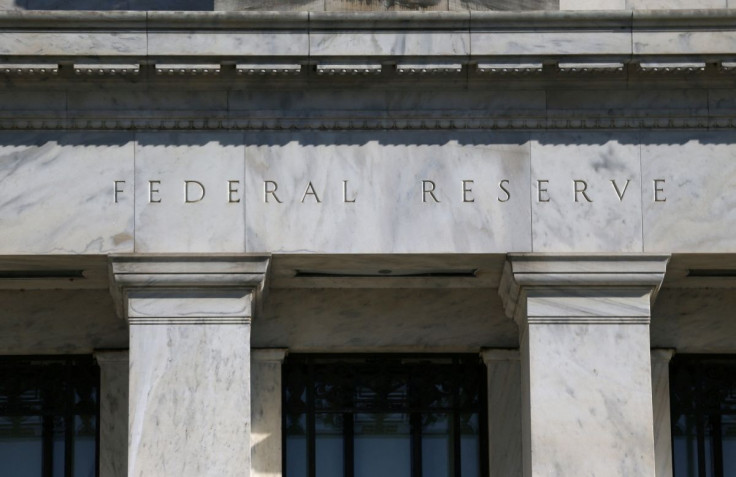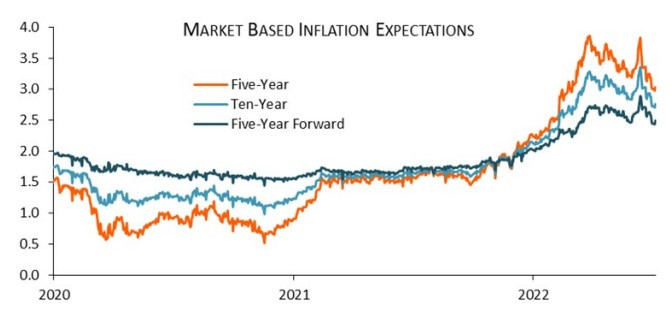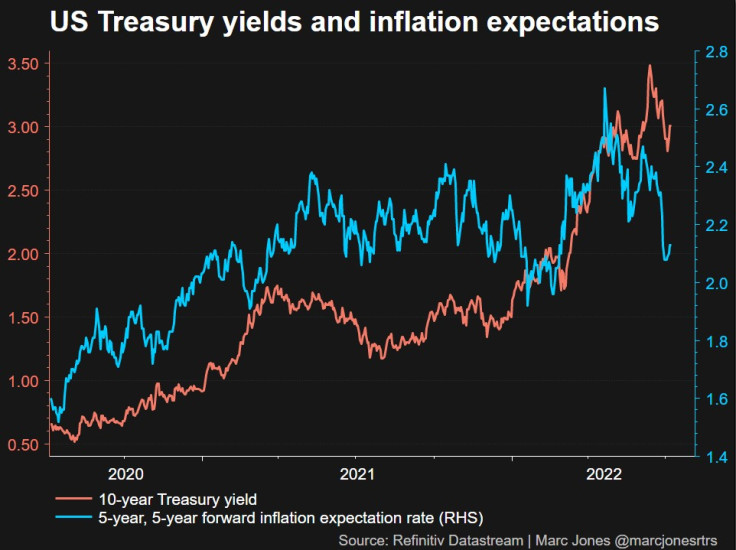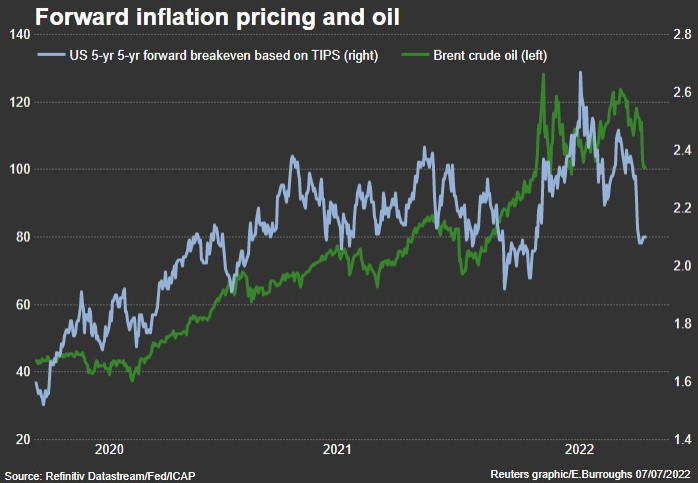Column-Rapid Fall In 'Core' Inflation Expectations Offers Fed Hope: McGeever

The Fed is nowhere near taking a victory lap on inflation, but some signals from the bond market suggest that day may not be quite as distant as policymakers had anticipated.
As recession fears yank commodity prices down from their recent peaks - last week, oil and copper had fallen 20% in less than a month - market-based inflation expectations have rapidly declined also.
Breakeven inflation rates embedded in five- and 10-year inflation-linked bonds, and 'five-year/five-year forward' inflation swaps, have retreated by as much as a full percentage point from highs in March and April, and as much as 50 basis points since the Fed's June 15-16 policy meeting.
Inflation expectations reflected by these financial market instruments are typically comprised of three components: term premium, liquidity premium, and outright expected inflation.
There is no prescribed formula for slicing and dicing them, so findings can vary wildly.
According to some models monitored by Roberto Perli and Benson Durham at Sandler Piper, both former Fed economists, the steep headline decline in recent weeks has been driven mainly by the inflation expectations component, which has offset moves in liquidity and term premiums.
Call it the 'core' measure of inflation expectations.
Durham's estimates suggest that since June 14, the eve of the Fed's two-day meeting, the expected inflation component of the 5-year Treasury Inflation Protected Securities (TIPS) yield has fallen around 60 basis points, and the equivalent measure in 10-year TIPS has fallen nearly 50 bps.
Durham reckons the expected inflation component embedded in five-year/five-year forwards has declined 37 bps, helping to reverse rise earlier this year. The year-to-date increase of around 50 bps is still around the 90th percentile of all six-month changes.
"The worst part has unequivocally gotten better. That is good news," Durham said. "The decline is meaningful, but the model can be volatile. It's encouraging though."
Such steep and rapid declines are rare. Benson notes that the fall in five-year forwards is around the 99th percentile of all three-week changes in absolute terms since TIPS started trading in 1999.
The last time there was a sustained decline like this was in the aftermath of the Great Financial Crisis. Similarly, the last time the broader measure of five-year breakeven inflation rates fell by a percentage point in a few months was in 2011.
GRAPHIC: Stripped out expected inflation - Piper Sandler

GRAPHIC: US bond yields & inflation expectations

ALL UNDER CONTROL?
This suggests investors think long-run inflation is under control, either by an economic 'soft landing' doing part of the Fed's work, or by the Fed deliberately making policy highly restrictive to kill inflation (and growth).
Right now, the first scenario looks more likely. Inflation expectations have come down but so has the Fed's so-called 'terminal rate', the market's estimate of where the fed funds rate will peak.
At the time of the Fed's June policy meeting, rates markets were betting the Fed would raise rates above 4% in the first half of next year. That is now around 3.50%, and was even lower earlier this month.
Right now, traders think the Fed won't go too far above its long-run estimate of the 'neutral' rate of interest around 2.5% for long, and are betting on long-term inflation of around 2.5%, not much above the Fed's goal of 2%.
It goes without saying that too much faith must not be put in one model. Economists, traders, and not least policymakers, will be scrutinizing a range of indicators for signs that inflation expectations have peaked and continue to decline.
GRAPHIC: UMich consumer inflation expectations

One of those is the University of Michigan's consumer survey of inflation expectations. The preliminary five-year June survey rose to 3.3%, enough to prompt the Fed to suddenly shift towards a 75 bps rate hike a few days later rather than the 50 bps move officials had widely flagged.
The final reading was revised back to 3.1%, calling the Fed's communications strategy and wider credibility into question. Still, with gas prices falling - dipping below $4 a gallon in some parts of the country - July's number could be lower still.
Many analysts point out that market-based inflation expectations measures like breakevens and forwards are distorted by the risk premiums embedded in them and their relatively low levels of liquidity.
"Breakevens don't have a particularly long history. In some instances, they react faster and earlier (to economic data), but ultimately it is consumers' inflation expectations that matter most to the Fed," said Francis Yared, global head of rates research at Deutsche Bank.
GRAPHIC: US inflation expectations and oil

(The opinions expressed here are those of the author, a columnist for Reuters.)
(By Jamie McGeever; editing by Diane Craft)
© Copyright Thomson Reuters 2024. All rights reserved.




















